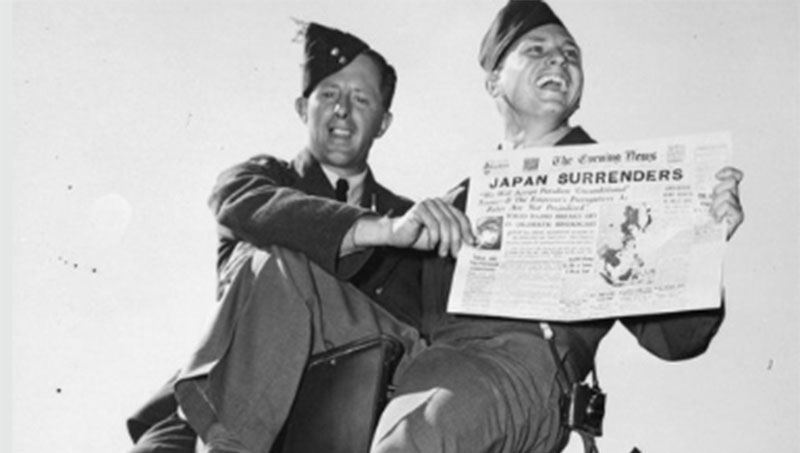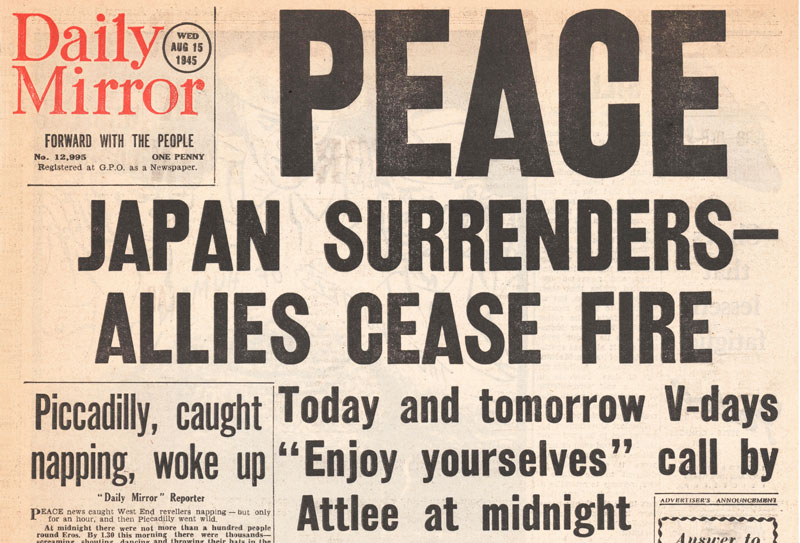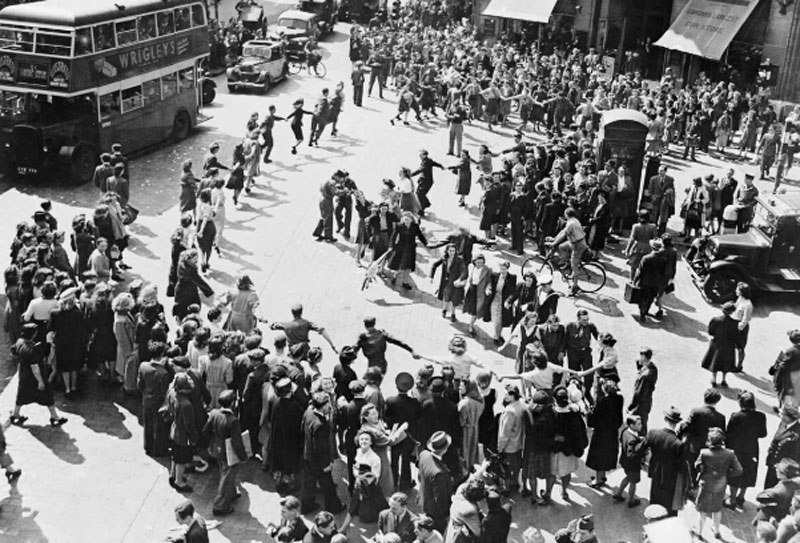The 75th anniversary of the end of the fighting in the Pacific – VJ Day
On 8th May 2020, the UK celebrated the 75th anniversary of the end of the Second World War – known as Victory in Europe or VE Day – and in most people’s minds that date marks the day when hostilities ceased and the Nazis were defeated. However, that was not the whole story, for while Europe had been fighting the Nazis on home territory, another limb of the war was being simultaneously fought many thousands of miles away in the Pacific and this bloody conflict was to continue for a further three months before its sudden end on 15th August 1945.
Photo: John Frost Newspapers / Alamy Stock Photo
On 27th September 1940, approximately a year after Neville Chamberlain had declared that the UK was at war with Germany, Japan, allied to Nazi Germany and Fascist Italy, signed the Tripartite Pact with those countries, in which the signatories declared support for one another and promised retaliation against any country that threatened them. The setting for a Far Eastern theatre of war was established.
War rages in the Far East
Japan had already begun an expansionist policy in China and an oil embargo imposed upon it by the US, coupled with US demands for Japan’s withdrawal from Chinese territory, only served to escalate tensions in the Pacific, an area where the US held considerable interests, as did the British.
The situation came to a head-on 7th December 1941 when the Japanese, in an attempt to cripple the US Navy fleet, sprang a surprise attack on the US forces based at Pearl Harbor, Hawaii. This was followed by attacks on British Hong Kong, British Malaya and the Philippines. If the US had not been fully committed to supporting the European Allies prior to this point, it was now, and the country entered the war.
While the US and Britain had the benefit of the latest technology of the time, Japan had the numerical advantage and the ability to attack strategically so that it was able to make territorial gains in the Philippines, Singapore, Borneo, Java, the Dutch East Indies and other areas. Burma (Myanmar) in particular, was an important region for the Japanese to control, especially the port of Rangoon, and British and Indian soldiers, known as the Chindits (or the ‘Forgotten Army’), were tasked with retaking the country, a long and difficult operation that was partially successful, but badly scarred by an excessive loss of life among those taking part.
Life in the prisoner-of-war camps
As the Japanese gained a stronghold in Asia, many British people who had been living and working in these countries suddenly found themselves rounded up and sent to what were effectively concentration camps. To add to their distress, families were split asunder, with women and children incarcerated separately from the men, the latter faring particularly badly as they were considered to represent a threat by their Japanese captors.
Conditions in the camps were brutal and although there was not the systematic mass genocide of the German Nazi camps, the death rate was nevertheless one in 20, and as high as one in four among captured servicemen, with an even greater proportion suffering long-term ill health years after their eventual release, mainly as a direct result of malnutrition and poor medical care. Hard enforced labour, lack of food and tropical diseases, especially dysentery, broke bodies, while sadistic and unpredictable treatment sought to break minds.
Even today, there are survivors of these camps, many of whom were captured as children or teenagers, and although they tell of a life of starvation, torture and desperation, they also speak of one characterised by close friendships and hope. Prisoners cared for one another, with the stronger ones supporting the weaker, especially in times of need. Bonds were formed between inmates, many lasting for decades after the war, through a shared history that was totally alien to others who had not gone through that same harrowing experience themselves.
A decisive blow
Meanwhile, outside the camps, the tide was turning for the Allied forces. Successful attacks on the Japanese military in New Guinea, followed by the liberation of the Philippines and later control of the Ogasawara Islands 620 miles directly south of Tokyo, meant that Japan’s downfall was inevitable. Yet still, despite heavy bombardments and devastating defeats, Japan refused to give up, choosing to ignore the Potsdam Declaration that demanded its unconditional surrender.
Added to this scenario was the fact that the Soviet Union was also entering the fray following the Yalta Agreement that looked to reorganise Europe and Germany at the end of hostilities in the European theatre. With Japan’s defeat apparently unavoidable by this point, the US, in an attempt to demonstrate its might to what was then the USSR, took the unprecedented – and controversial – step of dropping nuclear bombs on the cities of Hiroshima and Nagasaki, on 6th August and 9th August 1945 respectively. As a result of this devastating move, around 200,000 people were killed immediately and a further 150,000 died in the following weeks, months and years through exposure to the intense levels of radiation associated with these types of bombs.
The move proved to be decisive. Finally, on 15th August 1945, Japan admitted defeat and surrendered to the Allies, and on 2nd September, the official surrender documents were signed on board the battleship USS Missouri, moored in Tokyo Bay, finally drawing to a close what had truly become a world war, albeit one with an end that had come at such an enormous cost.
Photo: The Imperial War Museum
The people celebrate
The war was over, and in the UK, the country was in celebratory mood. Church bells were ringing, flags were flying, fireworks were set off and people were cramming the streets dancing and singing. In London, King George VI and Queen Elizabeth (later to become HRH Queen Elizabeth, the Queen Mother), led by the Household Cavalry, drove in an open carriage along the Mall and later in the day appeared on the balcony of Buckingham Palace, with their teenage daughters Princesses Elizabeth and Margaret, to wave at the cheering crowds below. In the evening, under the cover of darkness, the princesses famously escaped the confines of the palace to mingle and dance with the excited revellers in the streets, just as they had done a few months previously on VE Day.
At 9pm, the King, from his study at Buckingham Palace, addressed the nation and the Commonwealth via a radio broadcast, with the words, “Our hearts are full to overflowing, as are your own. Yet there is not one of us who has experienced this terrible war who does not realise that we shall feel its inevitable consequences long after we have all forgotten our rejoicings today.”
Meanwhile similarly enthusiastic celebrations also took place in other countries that had been involved in the conflict, most particularly the US, New Zealand and Australia. In Washington, DC, so enthusiastic was the crowd that a group tried to break into the grounds of the White House, demanding to see President Harry S Truman with shouts of, “We want Harry!” while in New York, two million people packed themselves into 10 blocks and a 20-minute cheer that went up following the announcement that the war had officially ended was described by the New York Times as a ‘victory roar’.
A time to reflect and remember
Today, commemorations and celebrations for both VE Day and VJ Day are bitter-sweet. While it is undoubtedly true that the end of war is a cause for joy, it is essential to also remember the huge human tragedy that took place between 1939 and 1945. The Second World War was the deadliest war in the history of mankind, with some casualty estimates put at 15,000,000 deaths in battle, 25,000,000 wounded in battle and 55,000,000 civilian deaths worldwide. These numbers are astounding and it is difficult to know the true figures as a large proportion of civilian deaths, as is so often the case in war, arose not necessarily as a direct result of the fighting but through the famine and disease that inevitably accompany it.
Today, with each year that passes, ever fewer veterans remain alive to remind us of this terrible conflict, and therefore while celebrating the fact that we have had 75 years of relative global peace since 1945, it is our duty too to remember those who gave so much not only for their own countries but for the whole world. We are truly indebted.
Two of the photos by kind permission of the Imperial War Museum, which is running a special programme, Victory 75, to commemorate the culmination of the Second World War. The programme includes Voices of War comprising audio recordings of people around the world as they recall what the end of hostilities meant to them. There is also a digital exhibition of artwork, I Saw the World End, by ES Devlin and Machiko Weston, marking the bombing of Hiroshima and Nagasaki. To visit these digital exhibitions, go to https://www.iwm.org.uk/history/victory .
By Halima Crabtree, LifeBook Editor.
Photo top right-hand side: Imperial War Museum. US Sergeant Franklin G Talley and an RAF airman hold up a copy of the Evening News while seated on traffic lights in Oxford Circus, London.



